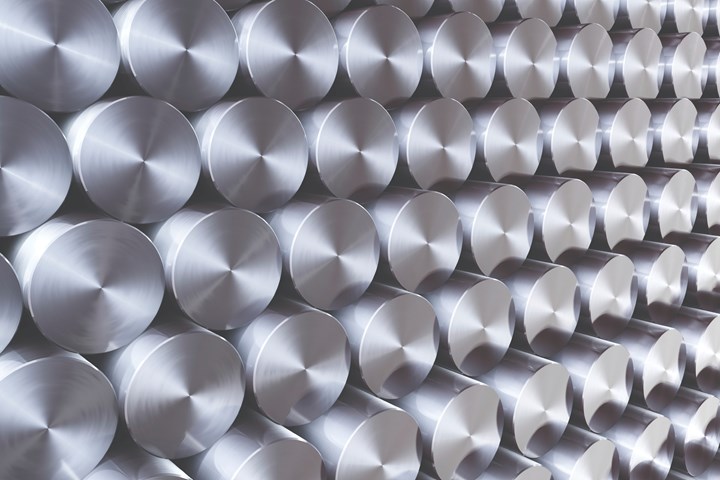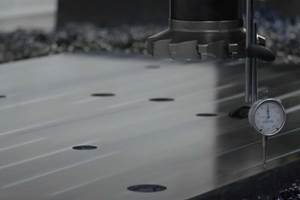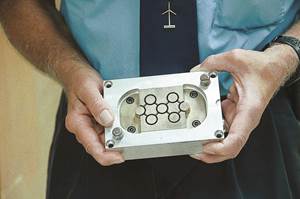What You Should Consider When Purchasing Modified P20 Steel
When buying P20 steels that have been modified, moldmakers must be aware of the variations and key issues that affect delivery, cost and lead times.
|
P20, a 4130, 4135 modified material, has long been the steel of choice for pre-hardened mold steels. P20 is classified as a chrome-moly alloy, with a carbon content of approximately 0.30 to 0.40. Over time, many variations on basic P20 chemistry have been introduced to the marketplace. Each modification can have an effect on the various processes used in the fabrication of a mold. Types of MaterialThe moldmaking industry in the U.S. is Eurocentric in nature. European immigrants came to the U.S. with trade backgrounds and had a large influence on the mold building industry. They naturally gravitated to building molds with the chrome-moly steels they were used to, such as DIN 1.2311 and DIN 1.2312, or their close cousin, AISI P20. P20 differs from region to region in the worldwide market. Europeans generally use the DIN spec materials (1.2311 and 1.2312), while in Japan, PX5 is the new standard P20. The Chinese market is less clear because the lack of information about the materials being used for their molds makes it difficult for secondary polishing and texturing processors to know what they are dealing with.
Figure 1 (below) shows a chemical breakdown of the materials used in the U.S. As the figure illustrates, there are variances within the P20 family, and depending on the steel supplier, an order for P20 could be filled with nearly any one of them. Two of the items listed in the table (P20 premium and high hard P20) are actually closer in chemistry to a 4340 material, which is a chrome-nickel-moly material. As noted earlier, P20 is in the 4130, 4135, 4140 (chrome-moly) family. These variations can affect costs and time for secondary processors. Most moldmakers look at two key issues when purchasing P20—machineability and stability. If the chemistry of the material lends itself to the formation of hard spots (carbide segregation), it can be much more difficult to machine. Machining cost can account for 50 percent or more of the cost of building a mold, so any increase in machining time can be expensive. Hard spots also cause reduced cutter and insert life, which will also increase costs. If the chemistry does not minimize hardness drop-off from the surface of the block to the center, it will cause increased stress in the steel. When the stress is relieved by machining away mass, the block will warp or twist out of shape, making it necessary to remove the steel from the machine at various intermediate stages and send the block out for thermal stress-relieving. The result is increased cost and lost lead time. Surface FinishOnce a mold leaves a shop, it usually requires a specific surface finish to be applied—polish, texture or EDM finish. The quality of the P20 being used can affect each aspect. Four factors determine the quality of the surface finish of P20 steels:
The alloy content of the variations of P20 also affects the welding process. The higher the steel's alloy content, the more susceptible it is to cracking. Many high-quality P20 versions from Asia (mainly Japan) have lower carbon contents and commensurately higher toughness. It is unusual for cracking to occur in these steels. The lower carbon content also keeps the hardness rise of the HAZ to just a few points. As the carbon content and the content of other alloys (such as nickel) are increased through the standard P20s and some of the high hard P20s—as well as on some of the DIN spec materials—pre- and post-heating becomes critical to controlling cracking and extreme hardness rise in the HAZ. This can add time and cost to the welding process. Making a DecisionExtreme pressure is being applied to leading steel producers in the U.S., Europe and Japan to develop new, advanced grades of mold steels. New melt and refining technologies, alloys and free machining additives are, or will be, available to moldmakers.
Until then, U.S. moldmakers will continue to use P20 because they understand the basic problems associated with the grade, and although it is costly, they can overcome those problems. It is like fighting with an old friend. However, moldmakers must keep in mind that overcoming most P20 problems requires that extra time and cost be built into the job. In this cost-reducing, lead time reducing world economy, moldmakers must eliminate these problems by looking at key issues that affect delivery and cost when purchasing variants of P20 to be competitive.
|
||||||||||||||||||
| Figure 1. |
Related Content
VIDEO: Innovative Materials Boost Mold Efficiency
Advancements in metal 3D printing and stainless steel optimize mold building for diverse, high-demand industries.
Read MoreVIDEO: AM Powder Addresses Current Inefficiencies, Sustainability and Skills Gap
Steel supplier discusses high thermal conductivity metal powders that also address the skills gaps via user-friendly materials and promote sustainability via durability and higher cycle counts.
Read MoreHow to Produce More Accurate Molds and Reduce Rework
Patented micro-milling process for manufacturing steel plate flat and parallel helps mold builders shorten mold build times and increase accuracy.
Read MoreHow to Select the Right Tool Steel for Mold Cavities
With cavity steel or alloy selection, there are many variables that can dictate the best option for moldmaking.
Read MoreRead Next
Reasons to Use Fiber Lasers for Mold Cleaning
Fiber lasers offer a simplicity, speed, control and portability, minimizing mold cleaning risks.
Read MoreHow to Use Continuing Education to Remain Competitive in Moldmaking
Continued training helps moldmakers make tooling decisions and properly use the latest cutting tool to efficiently machine high-quality molds.
Read More
















